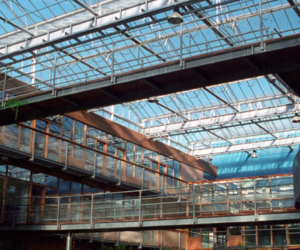Competition has its worth: it can provide significant motivation to work late in order to generate enough data to have your paper be first rather than a replicate study. The desire to ‘one-up’ a competitor’s lab can lead to researchers designing novel methods to study the system in question. It is not without its drawbacks either.
Collaboration, instead, allows for partnership between research groups that could advance scientific discoveries. Combining the greatest minds within a certain subfield of research both removes the pressure to publish first and increases the amount of data collected before discussion and results are integrated into a paper. Even though a lot of headway has been made on providing the means of collaboration, more work needs to be done in order for collaboration to become common practice.
Keywords: collaboration, education, architecture, research.
Edited by Shane Canning. Originally posted on F1000Blog!
Creating collaborative environments
Altering and modifying the current frameworks of how research is currently conducted can influence the culture of science towards a more collaborative one. From the American Academy of Arts and Sciences, a lecture series called Advancing Research in Science and Engineering (ARISE) reported actionable proposals to transcend cultural and structural barriers that would permit industry, research, and government to build better platforms for collaboration.
Some of the more structural recommendations included expanding research facilities and changing educational boundaries. These focus on the concrete and perhaps more abstract attributes that could influence more collaboration. Getting access to physical resources is a limitation, so making larger more open spaces and removing administrative barriers between disciplines could open doors to sharing materials and equipment.
Both the architectural groundworks and departmental and administrative changes impact how effectively a new collaborative project can be initiated and conducted.
Expanding research facilities
Apart from requiring better lighting or perhaps more windows to the outside world, research facilities have other complaints that can impede research. Buildings can often be too narrow with not enough space for mechanical equipment and do not have sufficient insulation for either cold rooms or regular lab bench space. Many research buildings, at least within the United States, were built in the post-war boom of the 1960s following the demand for universities and tech companies. Many buildings have had to be reconstructed, either with the addition of new wings or modified to accommodate change in scientific needs, but this can be difficult when there is no space to expand. Spatial limitations aside, interiors can still be inadequate with respect to fostering a science community.
Of course not every research building needs to be Google headquarters lined with transparent windows and open light, but the inclusion of a central space and more connectivity between laboratories can go a long way in allowing for more connectivity. Roger Goldstein, principal architect at MIT, asks these important questions when designing laboratory spaces:
- What actually constitutes a barrier to easy collaboration between researchers? Is there a difference between the impact of a door versus an opening in the wall?
- Does perceived flexibility, as measured by a researcher’s sense that he/she can modify the space, make a difference in the ability to do the best work?
- To what degree does visual clutter in a lab environment hinder one’s ability to think clearly or creatively?
More than just aesthetics of a building symbolizing connectivity, practicality must be taken into consideration. If varying departments from biology to physics and math to chemistry are working together to solve problems, many types of equipment are required to be within a building. This problem highlights the importance of flexibility within the architecture of a laboratory setting. Splitting the cost of new equipment between multiple departments would save money and potentially allow for more instruments to be obtained.
Educational boundaries
Even though this section is more geared towards academic divisions, it also has applications in industry. Within the past few decades, more disciplines have been merged together with the goal to fill gaps between the sciences such as bioinformatics, computational mathematics, and biomedical engineering. These new areas of research are often termed interdisciplinary, implying a space between disciplines. To better capture the extent of integration that collaboration requires, the term transdisciplinary denotes a spanning of disciplines. Even though this may seem like a trivial semantic difference, the implication behind the meaning of these words affects the culture in which science is conducted.
This is not to say, however, that there should be less specialization in a field, but that there should be less rigid borders between fields. Transdisciplinary, instead of phasing out experts for a more ‘jack-of-all trades,’ calls for more experts to think cleverly and creatively, and use methods from other fields. For this to happen, academic institutes need to break barriers to promote sharing of tools and expertise and find similarities between very different areas of investigation.
Take away message
Changing the culture of science will be a difficult, but having architectural and institutional changes is a good first step in promoting collaboration. Buildings and research institutions and reducing the amount of institutional overhead reduce physical and mental barriers along with, not only supporting, but promoting collaborative projects. With that said, these changes might not be enough: just because a space exists does not mean that people will occupy and use it. Moreover, changes in networking and software would also need to be implemented to get a fuller effect on a culture change since technology has become integral to how science is conducted.
I’d like to thank F1000 for giving me the opportunity to write for them and I look forward to doing so in the future! Coming soon will be a follow up on this article looking more into the role of software and open access to facilitate collaboration.


Leave a Reply